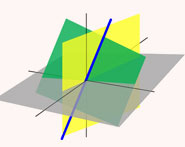


 تاريخ الرياضيات
تاريخ الرياضيات
 الرياضيات في الحضارات المختلفة
الرياضيات في الحضارات المختلفة 
 الرياضيات المتقطعة
الرياضيات المتقطعة
 الجبر
الجبر
 الهندسة
الهندسة 
 المعادلات التفاضلية و التكاملية
المعادلات التفاضلية و التكاملية 
 التحليل
التحليل
 علماء الرياضيات
علماء الرياضيات |
Read More
Date: 27-3-2016
Date: 27-3-2016
Date: 21-3-2016
|
Born: 15 October 1735 in Salterhebble, near Halifax, Yorkshire, England
Died: 5 November 1800 in Brighton, Sussex, England

Jesse Ramsden's father was Thomas Ramsden who was an innkeeper. The family were not well off and Jesse attended a free school in Halifax from 1744 to 1747. At this stage Ramsden was sent to live with his uncle, Mr Craven, in the North Riding of Yorkshire, and he spent four years there studying mathematics taught by the Revd Mr Hall.
Around 1751 he was apprenticed to a cloth maker, and he spent until 1755 serving his apprenticeship. He went to London at this stage and was given a job as a clerk in a cloth warehouse but, in 1756 at the age of 21, he chose to become an apprentice to Mark Burton, a mathematical instrument maker inDenmark Street in the Strand. By the age of 27 he had his own business in London in the Strand where he became acknowledged as the most skilful designer of mathematical, astronomical, surveying and navigational instruments in the 18th century. A near neighbour was John Dollond, a fellow of the Royal Society and a skilled designer of optical instruments. Ramsden spent much time at Dollond's house learning about optical instruments. There he met Sarah Dollond, John Dollond's daughter, and they were married on 16 August 1766. Of their two sons and two daughters, only one son, John Ramsden, survived to adulthood. Marriage gave Ramsden a share in the patent that John Dollond had taken out on his most famous invention, the achromatic lens. Ramsden soon opened a new business in Haymarket, near Little Suffolk Street.
The French scientist N Cassegrain proposed a design of a reflecting telescope in 1672. It was Ramsden, however, 100 years later who found that this design reduces blurring of the image caused by the sphericity of the lenses or mirrors. Optical instruments at this time were important for a number of reasons, but the big problem of the day which many scientists attacked, was solving the problem of computing longitude at sea. One method involved using tables of the moon's position which had been produced by Tobias Mayer and he sent to the British government in 1755. Maskelyne had also compiled lunar tables but accurate instruments were needed to be able to take bearings from ships before they were useful. Ramsden produced such an instrument in 1767 but it did not give as accurate results as was hoped. A second version produced in 1775 was considerably better and led to Ramsden being awarded £300 two years later by the longitude commissioners. See [6] where Ramsden's contribution to the longitude problem is discussed.
Although he was highly successful in his business, Ramsden does not appear to have been so successful with his marriage for his wife did not move with him when he opened larger premises in 1773. Sarah and their son John moved into a house owned by the Dollond family, but Sarah seems to have continued to assist Ramsden in his business. Indeed Ramsden continued to expand his business, enlarging his premises in 1780. His also continued to devise important new inventions, one of these being the circular dividing engine. This allowed for the mass production of instruments such as sextants, for the dividing engine provided mechanical graduation of scales. The instrument is described in [5] where Brooks provides the following summary:-
The development of the circular dividing engine in England is traced from Henry Hindley and Jesse Ramsden through the improvements introduced by Ramsden's successors to the self-acting engine of William Simms. Particular emphasis is given to the invention, evolution and transmission of the methods used to achieve accuracy in dividing the wheel, ratcheting the teeth and matching them to the endless screw, and mounting the cutter. The procedures adopted by Ramsden and Troughton for correcting initial dividing marks are also described.
Ramsden was elected fellow of the Royal Society on 12 January 1786 and received the Copley Medal in 1795 for:-
... various inventions and improvements to philosophical instruments.
He was elected to the St Petersburg Academy of Sciences in 1794.
In [4] details of Ramsden's appearance and character are given. He was:-
... above the middle size, slender, but extremely well-made, and to a late period of life, possessed of great activity. His countenance was a faithful index of his mind, full of intelligence and sweetness. His forehead was open, and high, with a very projecting and expressive brow. His eyes were dark hazel, sparkling with animation. He had a good musical voice.
This quote was by the Revd Louis Dutens who also said that Ramsden [2]:-
... spent his evenings in the kitchen with his apprentices, eating bread and butter, discussing ideas, and perfecting designs. Several of his apprentices went on to distinguished careers in their own right ...
Ramsden's health deteriorated and he was advised to go to Brighton to aid his recovery. This did not happen and Ramsden died there.
Books:
Articles:



|
|
|
|
للعاملين في الليل.. حيلة صحية تجنبكم خطر هذا النوع من العمل
|
|
|
|
|
|
|
"ناسا" تحتفي برائد الفضاء السوفياتي يوري غاغارين
|
|
|
|
|
|
|
نحو شراكة وطنية متكاملة.. الأمين العام للعتبة الحسينية يبحث مع وكيل وزارة الخارجية آفاق التعاون المؤسسي
|
|
|